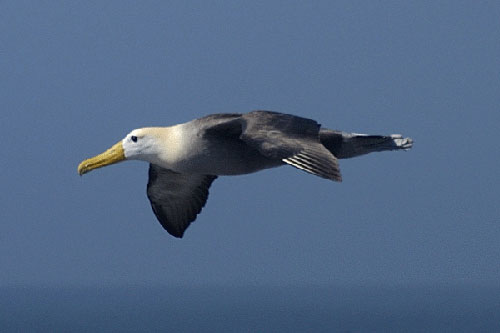Mark Bolton (RSPB Centre for Conservation Science, Royal Society for the Protection of Birds, Sandy, U.K.) and colleagues have reviewed free access in the ornithological journal Ibis inter‐colony segregation of foraging areas of seabirds, including of five species (eight studies) of ACAP-listed albatrosses and petrels (in the genera Phoebastria, Phoebetria, Thalassarche and Macronectes) and four species (eight studies) of shearwaters (Ardenna, Calonectris, Puffinus).
The paper’s abstract follows:
“Understanding the determinants of species’ distributions is a fundamental aim in ecology and a prerequisite for conservation but is particularly challenging in the marine environment. Advances in bio‐logging technology have resulted in a rapid increase in studies of seabird movement and distribution in recent years. Multi‐colony studies examining the effects of intra‐ and inter‐colony competition on distribution have found that several species exhibit inter‐colony segregation of foraging areas, rather than overlapping distributions. These findings are timely given the increasing rate of human exploitation of marine resources and the need to make robust assessments of likely impacts of proposed marine developments on biodiversity. Here we review the occurrence of foraging area segregation reported by published tracking studies in relation to the density‐dependent hinterland (DDH) model, which predicts that segregation occurs in response to inter‐colony competition, itself a function of colony size, distance from the colony and prey distribution. We found that inter‐colony foraging area segregation occurred in 79% of 39 studies. The frequency of occurrence was similar across the four seabird orders for which data were available, and included species with both smaller (10–100 km) and larger (100–1000 km) foraging ranges. Many predictions of the DDH model were confirmed, with examples of segregation in response to high levels of inter‐colony competition related to colony size and proximity, and enclosed landform restricting the extent of available habitat. Moreover, as predicted by the DDH model, inter‐colony overlap tended to occur where birds aggregated in highly productive areas, often remote from all colonies. The apparent prevalence of inter‐colony foraging segregation has important implications for assessment of impacts of marine development on protected seabird colonies. If a development area is accessible from multiple colonies, it may impact those colonies much more asymmetrically than previously supposed. Current impact assessment approaches that do not consider spatial inter‐colony segregation will therefore be subject to error. We recommend the collection of tracking data from multiple colonies and modelling of inter‐colony interactions to predict colony‐specific distributions.”

Globally Critically Endangered Waved Albatross Phoebastria irrorata in flight, one of the studied ACAP species, photograph by Barry Baker
Reference:
Bolton, M., Conolly, G., Ewan, M.C., Wakefield, D. & Caldow, R. 2018. A review of the occurrence of and the implications for marine environmental impact assessment. Ibis doi.org/10.1111/ibi.12677.
John Cooper, ACAP Information Officer, 15 November 2018

 English
English  Français
Français  Español
Español